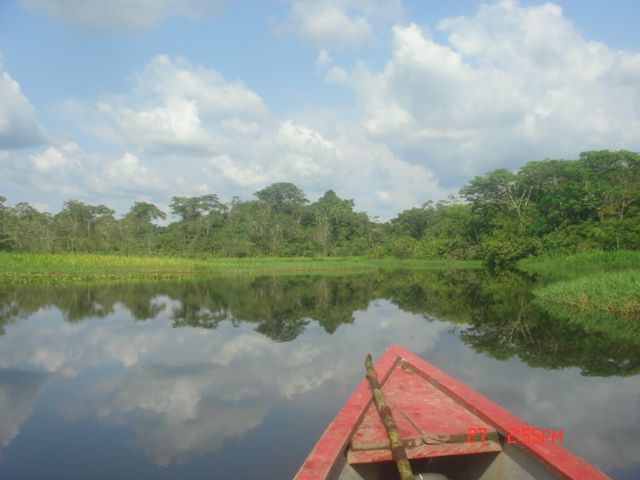mongabay.com
October 27, 2009
Ecuador's Yasuni National Park is full of wealth: it is one of the richest places on earth in terms of biodiversity; it is home to the indigenous Waorani people, as well as several uncontacted tribes; and the park's forest and soil provides a massive carbon sink.
However, Yasuni National Park also sits on wealth of a different kind: one billion barrels of oil remain locked under the pristine rainforest. While drilling for oil has brought huge profits--the commodity is Ecuador's top export--it has also brought environmental destruction and conflicts with indigenous groups, including a legal one between several tribes and Chevorn highlighted by the new film Crude.
In a country where oil extraction has a long, bloody, and contentious past, President Rafael Correa put forth a novel idea, known as the Yasuni-ITT Initiative. He announced in 2007 that he would not touch the oil if the international community compensated Ecuador. He said that leaving the oil would help achieve three international objectives: protecting biodiversity, respecting the rights of indigenous people, and combating climate change, since it is estimated that extracting the oil would release 410 million metric tons of carbon.
"Oil and gas concessions now cover vast swaths of the mega-diverse western Amazon. Ecuador´s revolutionary initiative is the first major government-led effort to buck this disturbing trend," says Dr. Matt Finer from Save America's Forests. Finer is the lead author of a new paper in Biotropica that looks at the viability of Yasuni-ITT, and the hurdles it will have to jump to even be implemented.
 Yasuni National Park in Ecuador. Photo by Matt Finer © Save America’s Forests. |
"The best way to minimize the risk associated with the carbon bonds is to encourage supporters to make direct donations," said Remi Moncel of the World Resources Institute. "While less problematic from the point of view of environmental integrity, it is harder to raise money that way."
Yasuni-ITT is an example of just how difficult such donations are. Germany has been the largest verbal supporter of Yasuni-ITT. Numbers have been tossed around, but the nation has yet to put forward any real money and recent reports suggest that Germany may be backing-off original promises. Other European nations have shown interest including Spain and France.
Despite the difficulties facing Yasuni-ITT—including making certain that countries compensating Ecuador won't decide to drill for themselves in the future—the researchers believe that Yasuni-ITT will become a model both for oil and gas drilling in areas where it would lead to environmental degradation, biodiversity loss, or local conflict, that is, should it succeed. As well, the authors say, Yasuni-ITT should be looked at as a creative way to combat climate change.
"The climate conference of Copenhagen is only weeks away. What Ecuador has proposed is a good example of how each country can come up with home-grown, nationally relevant ideas to promote sustainable development," Moncel said.
Dr. Clinton Jenkins of the University of Maryland says that the future of Yasuni national Park will ultimately rest on the value's of global society: "Yasuní is an exceptional place in the world, biologically incredible, home to uncontacted peoples, and yet – perhaps tragically – full of oil. Society faces a test of what we value more, drilling for more oil, or preserving a cherished national park and the people who call it home."
In terms of biodiversity Yasuni National Park supports 150 amphibian species and 121 reptiles (the highest numbers of herpetofauna on earth), in addition to 600 species of bird and 200 mammals. Such numbers are always changing, since new species are discovered frequently.
The reserve is also home to the Waorani people. In the past the warlike tribe often defended their homes violently: they became famous for spearing oil workers, missionaries, and illegal loggers, while the infringement on their territory by the wider world led to several epidemics and cultural upheaval. Tribes—both related and only distantly related to the Waorani—still remain uncontacted in the park today, such as the Tagaeri and Taromenane.
Due to the unique place that Yasuni National Park holds not just for Ecuador (it's the country's only Amazonian park), but for the world, it was designated a Man and Biosphere Reserve by UNESCO in 1989.
Citations:
Matt Finer, Remi Moncel, and Clinton N. Jenkins. Leaving the Oil Under the Amazon: Ecuador's Yasuni –ITT Initiative. Biotropica, October 2009. 10.1111/j.1744-7429.2009.00587.x.
Matt Finer, Varsha Vijay, Fernando Ponce, Clinton N Jenkins, and Ted R Kahn. Ecuador’s Yasuni Biosphere Reserve: a brief modern history and conservation challenges. Environmental Research Letters 4 (2009) 034005.


No comments:
Post a Comment